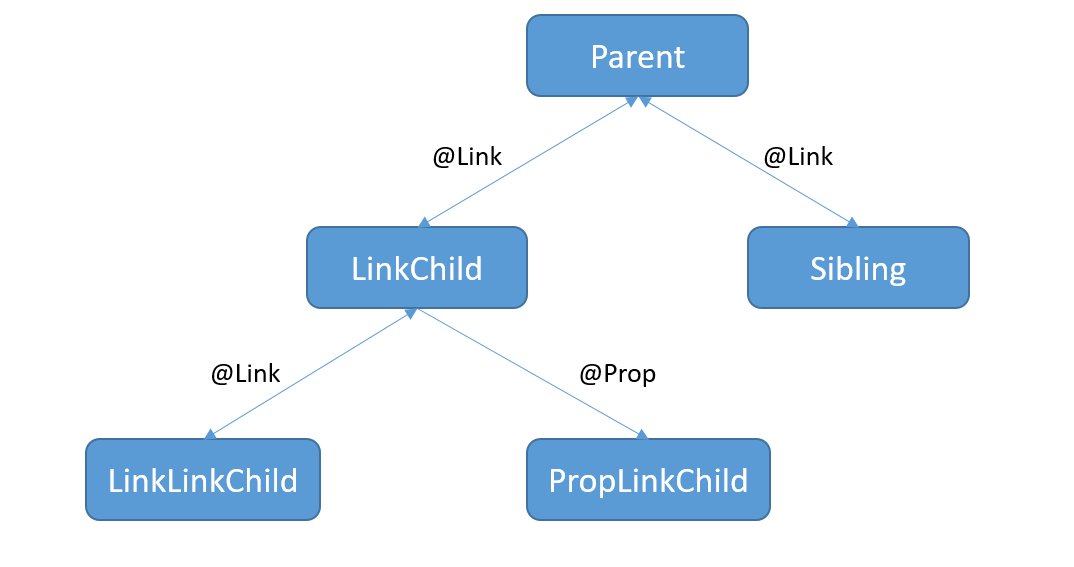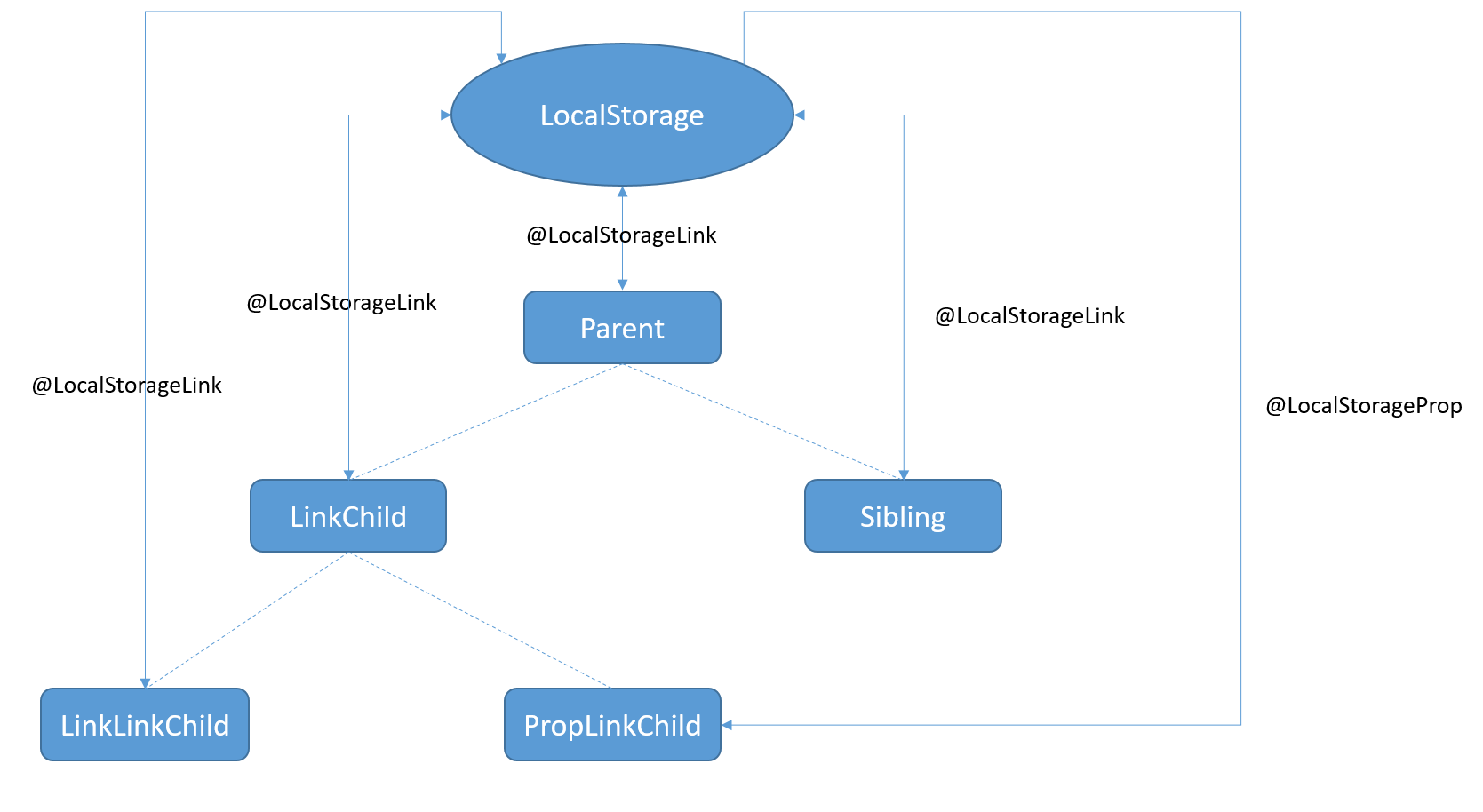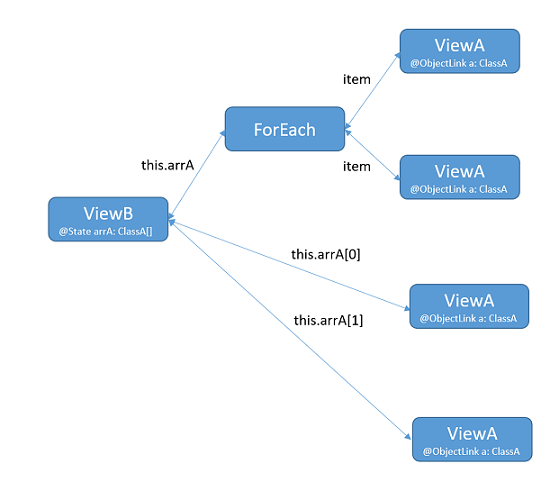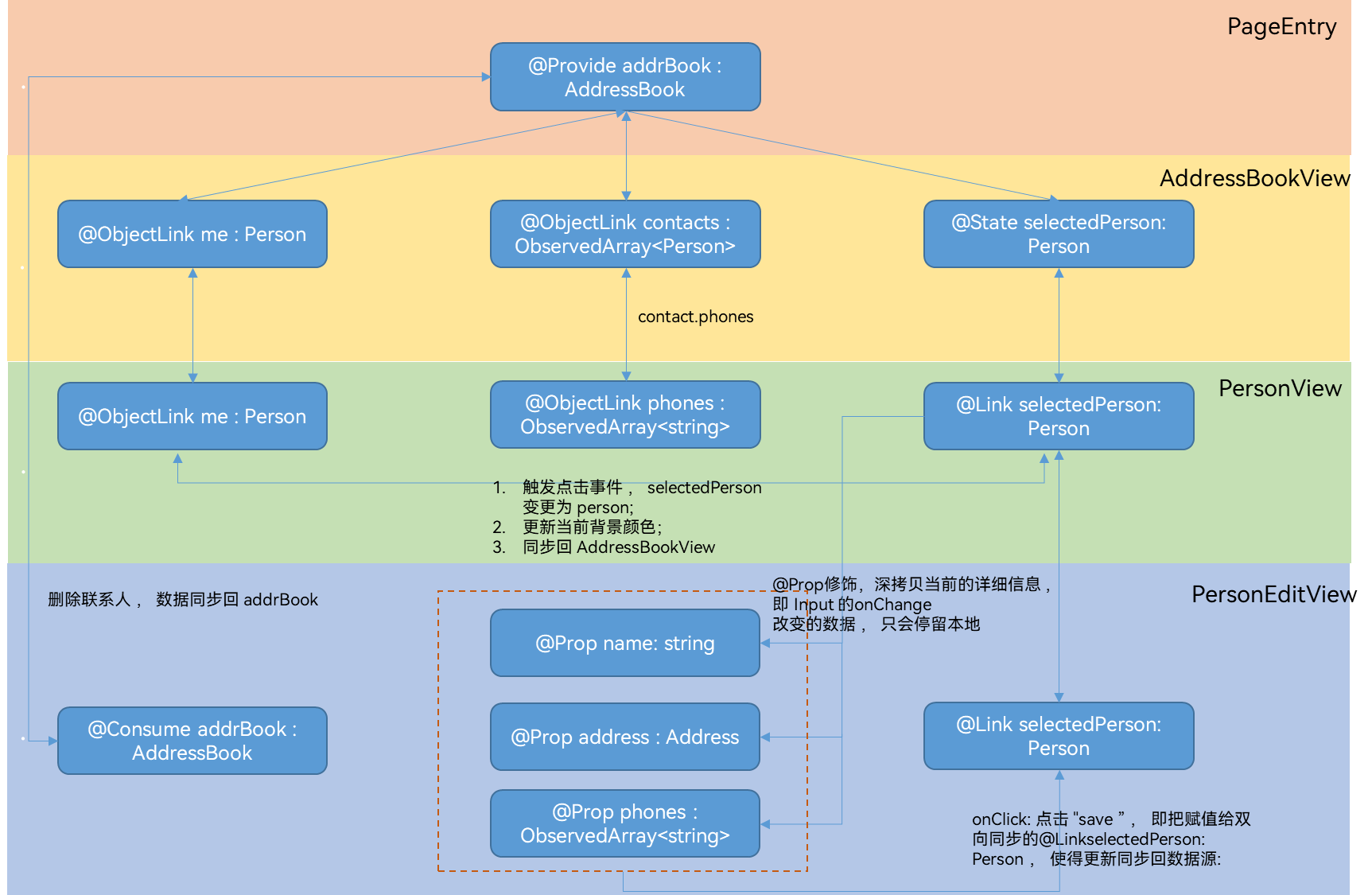harmony 鸿蒙MVVM模式
MVVM模式
应用通过状态去渲染更新UI是程序设计中相对复杂,但又十分重要的,往往决定了应用程序的性能。程序的状态数据通常包含了数组、对象,或者是嵌套对象组合而成。在这些情况下,ArkUI采取MVVM = Model + View + ViewModel模式,其中状态管理模块起到的就是ViewModel的作用,将数据与视图绑定在一起,更新数据的时候直接更新视图。
Model层:存储数据和相关逻辑的模型。它表示组件或其他相关业务逻辑之间传输的数据。Model是对原始数据的进一步处理。
View层:在ArkUI中通常是\@Components修饰组件渲染的UI。
ViewModel层:在ArkUI中,ViewModel是存储在自定义组件的状态变量、LocalStorage和AppStorage中的数据。
- 自定义组件通过执行其build()方法或者\@Builder装饰的方法来渲染UI,即ViewModel可以渲染View。
- View可以通过相应event handler来改变ViewModel,即事件驱动ViewModel的改变,另外ViewModel提供了\@Watch回调方法用于监听状态数据的改变。
- 在ViewModel被改变时,需要同步回Model层,这样才能保证ViewModel和Model的一致性,即应用自身数据的一致性。
- ViewModel结构设计应始终为了适配自定义组件的构建和更新,这也是将Model和ViewModel分开的原因。
目前很多关于UI构造和更新的问题,都是由于ViewModel的设计并没有很好的支持自定义组件的渲染,或者试图去让自定义组件强行适配Model层,而中间没有用ViewModel来进行分离。例如,一个应用程序直接将SQL数据库中的数据读入内存,这种数据模型不能很好的直接适配自定义组件的渲染,所以在应用程序开发中需要适配ViewModel层。

根据上面涉及SQL数据库的示例,应用程序应设计为:
Model:针对数据库高效操作的数据模型。
ViewModel:针对ArkUI状态管理功能进行高效的UI更新的视图模型。
部署 converters/adapters: converters/adapters作用于Model和ViewModel的相互转换。
- converters/adapters可以转换最初从数据库读取的Model,来创建并初始化ViewModel。
- 在应用的使用场景中,UI会通过event handler改变ViewModel,此时converters/adapters需要将ViewModel的更新数据同步回Model。
虽然与强制将UI拟合到SQL数据库模式(MV模式)相比,MVVM的设计比较复杂,但应用程序开发人员可以通过ViewModel层的隔离,来简化UI的设计和实现,以此来收获更好的UI性能。
ViewModel的数据源
ViewModel通常包含多个顶层数据源。\@State和\@Provide装饰的变量以及LocalStorage和AppStorage都是顶层数据源,其余装饰器都是与数据源做同步的数据。装饰器的选择取决于状态需要在自定义组件之间的共享范围。共享范围从小到大的排序是:
\@State:组件级别的共享,通过命名参数机制传递,例如:CompA: ({ aProp: this.aProp }),表示传递层级(共享范围)是父子之间的传递。
\@Provide:组件级别的共享,可以通过key和\@Consume绑定,因此不用参数传递,实现多层级的数据共享,共享范围大于\@State。
LocalStorage:页面级别的共享,可以通过\@Entry在当前组件树上共享LocalStorage实例。
AppStorage:应用全局的UI状态存储,和应用进程绑定,在整个应用内的状态数据的共享。
\@State装饰的变量与一个或多个子组件共享状态数据
\@State可以初始化多种状态变量,\@Prop、\@Link和\@ObjectLink可以和其建立单向或双向同步,详情见@State使用规范。
- 使用Parent根节点中\@State装饰的testNum作为ViewModel数据项。将testNum传递给其子组件LinkChild和Sibling。
// xxx.ets
@Entry
@Component
struct Parent {
@State @Watch("testNumChange1") testNum: number = 1;
testNumChange1(propName: string): void {
console.log(`Parent: testNumChange value ${this.testNum}`)
}
build() {
Column() {
LinkChild({ testNum: $testNum })
Sibling({ testNum: $testNum })
}
}
}
- LinkChild和Sibling中用\@Link和父组件的数据源建立双向同步。其中LinkChild中创建了LinkLinkChild和PropLinkChild。
@Component
struct Sibling {
@Link @Watch("testNumChange") testNum: number;
testNumChange(propName: string): void {
console.log(`Sibling: testNumChange value ${this.testNum}`);
}
build() {
Text(`Sibling: ${this.testNum}`)
}
}
@Component
struct LinkChild {
@Link @Watch("testNumChange") testNum: number;
testNumChange(propName: string): void {
console.log(`LinkChild: testNumChange value ${this.testNum}`);
}
build() {
Column() {
Button('incr testNum')
.onClick(() => {
console.log(`LinkChild: before value change value ${this.testNum}`);
this.testNum = this.testNum + 1
console.log(`LinkChild: after value change value ${this.testNum}`);
})
Text(`LinkChild: ${this.testNum}`)
LinkLinkChild({ testNumGrand: $testNum })
PropLinkChild({ testNumGrand: this.testNum })
}
.height(200).width(200)
}
}
- LinkLinkChild和PropLinkChild声明如下,PropLinkChild中的\@Prop和其父组件建立单向同步关系。
@Component
struct LinkLinkChild {
@Link @Watch("testNumChange") testNumGrand: number = 0;
testNumChange(propName: string): void {
console.log(`LinkLinkChild: testNumGrand value ${this.testNumGrand}`);
}
build() {
Text(`LinkLinkChild: ${this.testNumGrand}`)
}
}
@Component
struct PropLinkChild {
@Prop @Watch("testNumChange") testNumGrand: number = 0;
testNumChange(propName: string): void {
console.log(`PropLinkChild: testNumGrand value ${this.testNumGrand}`);
}
build() {
Text(`PropLinkChild: ${this.testNumGrand}`)
.height(70)
.backgroundColor(Color.Red)
.onClick(() => {
this.testNumGrand += 1;
})
}
}

当LinkChild中的\@Link testNum更改时。
更改首先同步到其父组件Parent,然后更改从Parent同步到Siling。
LinkChild中的\@Link testNum更改也同步给子组件LinkLinkChild和PropLinkChild。
\@State装饰器与\@Provide、LocalStorage、AppStorage的区别:
- \@State如果想要将更改传递给孙子节点,需要先将更改传递给子组件,再从子节点传递给孙子节点。
- 共享只能通过构造函数的参数传递,即命名参数机制CompA: ({ aProp: this.aProp })。
完整的代码示例如下:
@Component
struct LinkLinkChild {
@Link @Watch("testNumChange") testNumGrand: number = 0;
testNumChange(propName: string): void {
console.log(`LinkLinkChild: testNumGrand value ${this.testNumGrand}`);
}
build() {
Text(`LinkLinkChild: ${this.testNumGrand}`)
}
}
@Component
struct PropLinkChild {
@Prop @Watch("testNumChange") testNumGrand: number = 0;
testNumChange(propName: string): void {
console.log(`PropLinkChild: testNumGrand value ${this.testNumGrand}`);
}
build() {
Text(`PropLinkChild: ${this.testNumGrand}`)
.height(70)
.backgroundColor(Color.Red)
.onClick(() => {
this.testNumGrand += 1;
})
}
}
@Component
struct Sibling {
@Link @Watch("testNumChange") testNum: number;
testNumChange(propName: string): void {
console.log(`Sibling: testNumChange value ${this.testNum}`);
}
build() {
Text(`Sibling: ${this.testNum}`)
}
}
@Component
struct LinkChild {
@Link @Watch("testNumChange") testNum: number;
testNumChange(propName: string): void {
console.log(`LinkChild: testNumChange value ${this.testNum}`);
}
build() {
Column() {
Button('incr testNum')
.onClick(() => {
console.log(`LinkChild: before value change value ${this.testNum}`);
this.testNum = this.testNum + 1
console.log(`LinkChild: after value change value ${this.testNum}`);
})
Text(`LinkChild: ${this.testNum}`)
LinkLinkChild({ testNumGrand: $testNum })
PropLinkChild({ testNumGrand: this.testNum })
}
.height(200).width(200)
}
}
@Entry
@Component
struct Parent {
@State @Watch("testNumChange1") testNum: number = 1;
testNumChange1(propName: string): void {
console.log(`Parent: testNumChange value ${this.testNum}`)
}
build() {
Column() {
LinkChild({ testNum: $testNum })
Sibling({ testNum: $testNum })
}
}
}
\@Provide装饰的变量与任何后代组件共享状态数据
\@Provide装饰的变量可以与任何后代组件共享状态数据,其后代组件使用\@Consume创建双向同步,详情见@Provide和@Consume。
因此,\@Provide-\@Consume模式比使用\@State-\@Link-\@Link从父组件将更改传递到孙子组件更方便。\@Provide-\@Consume适合在单个页面UI组件树中共享状态数据。
使用\@Provide-\@Consume模式时,\@Consume和其祖先组件中的\@Provide通过绑定相同的key连接,而不是在组件的构造函数中通过参数来进行传递。
以下示例通过\@Provide-\@Consume模式,将更改从父组件传递到孙子组件。
@Component
struct LinkLinkChild {
@Consume @Watch("testNumChange") testNum: number = 0;
testNumChange(propName: string): void {
console.log(`LinkLinkChild: testNum value ${this.testNum}`);
}
build() {
Text(`LinkLinkChild: ${this.testNum}`)
}
}
@Component
struct PropLinkChild {
@Prop @Watch("testNumChange") testNumGrand: number = 0;
testNumChange(propName: string): void {
console.log(`PropLinkChild: testNumGrand value ${this.testNumGrand}`);
}
build() {
Text(`PropLinkChild: ${this.testNumGrand}`)
.height(70)
.backgroundColor(Color.Red)
.onClick(() => {
this.testNumGrand += 1;
})
}
}
@Component
struct Sibling {
@Consume @Watch("testNumChange") testNum: number;
testNumChange(propName: string): void {
console.log(`Sibling: testNumChange value ${this.testNum}`);
}
build() {
Text(`Sibling: ${this.testNum}`)
}
}
@Component
struct LinkChild {
@Consume @Watch("testNumChange") testNum: number;
testNumChange(propName: string): void {
console.log(`LinkChild: testNumChange value ${this.testNum}`);
}
build() {
Column() {
Button('incr testNum')
.onClick(() => {
console.log(`LinkChild: before value change value ${this.testNum}`);
this.testNum = this.testNum + 1
console.log(`LinkChild: after value change value ${this.testNum}`);
})
Text(`LinkChild: ${this.testNum}`)
LinkLinkChild({ /* empty */ })
PropLinkChild({ testNumGrand: this.testNum })
}
.height(200).width(200)
}
}
@Entry
@Component
struct Parent {
@Provide @Watch("testNumChange1") testNum: number = 1;
testNumChange1(propName: string): void {
console.log(`Parent: testNumChange value ${this.testNum}`)
}
build() {
Column() {
LinkChild({ /* empty */ })
Sibling({ /* empty */ })
}
}
}
给LocalStorage实例中对应的属性建立双向或单向同步
通过\@LocalStorageLink和\@LocalStorageProp,给LocalStorage实例中的属性建立双向或单向同步。可以将LocalStorage实例视为\@State变量的Map,使用详情参考LocalStorage。
LocalStorage对象可以在ArkUI应用程序的几个页面上共享。因此,使用\@LocalStorageLink、\@LocalStorageProp和LocalStorage可以在应用程序的多个页面上共享状态。
以下示例中:
创建一个LocalStorage实例,并通过\@Entry(storage)将其注入根节点。
在Parent组件中初始化\@LocalStorageLink(“testNum”)变量时,将在LocalStorage实例中创建testNum属性,并设置指定的初始值为1,即\@LocalStorageLink(“testNum”) testNum: number = 1。
在其子组件中,都使用\@LocalStorageLink或\@LocalStorageProp绑定同一个属性名key来传递数据。
LocalStorage可以被认为是\@State变量的Map,属性名作为Map中的key。
\@LocalStorageLink和LocalStorage中对应的属性的同步行为,和\@State和\@Link一致,都为双向数据同步。
以下为组件的状态更新图:

@Component
struct LinkLinkChild {
@LocalStorageLink("testNum") @Watch("testNumChange") testNum: number = 1;
testNumChange(propName: string): void {
console.log(`LinkLinkChild: testNum value ${this.testNum}`);
}
build() {
Text(`LinkLinkChild: ${this.testNum}`)
}
}
@Component
struct PropLinkChild {
@LocalStorageProp("testNum") @Watch("testNumChange") testNumGrand: number = 1;
testNumChange(propName: string): void {
console.log(`PropLinkChild: testNumGrand value ${this.testNumGrand}`);
}
build() {
Text(`PropLinkChild: ${this.testNumGrand}`)
.height(70)
.backgroundColor(Color.Red)
.onClick(() => {
this.testNumGrand += 1;
})
}
}
@Component
struct Sibling {
@LocalStorageLink("testNum") @Watch("testNumChange") testNum: number = 1;
testNumChange(propName: string): void {
console.log(`Sibling: testNumChange value ${this.testNum}`);
}
build() {
Text(`Sibling: ${this.testNum}`)
}
}
@Component
struct LinkChild {
@LocalStorageLink("testNum") @Watch("testNumChange") testNum: number = 1;
testNumChange(propName: string): void {
console.log(`LinkChild: testNumChange value ${this.testNum}`);
}
build() {
Column() {
Button('incr testNum')
.onClick(() => {
console.log(`LinkChild: before value change value ${this.testNum}`);
this.testNum = this.testNum + 1
console.log(`LinkChild: after value change value ${this.testNum}`);
})
Text(`LinkChild: ${this.testNum}`)
LinkLinkChild({ /* empty */ })
PropLinkChild({ /* empty */ })
}
.height(200).width(200)
}
}
// create LocalStorage object to hold the data
const storage = new LocalStorage();
@Entry(storage)
@Component
struct Parent {
@LocalStorageLink("testNum") @Watch("testNumChange1") testNum: number = 1;
testNumChange1(propName: string): void {
console.log(`Parent: testNumChange value ${this.testNum}`)
}
build() {
Column() {
LinkChild({ /* empty */ })
Sibling({ /* empty */ })
}
}
}
给AppStorage中对应的属性建立双向或单向同步
AppStorage是LocalStorage的单例对象,ArkUI在应用程序启动时创建该对象,在页面中使用\@StorageLink和\@StorageProp为多个页面之间共享数据,具体使用方法和LocalStorage类似。
也可以使用PersistentStorage将AppStorage中的特定属性持久化到本地磁盘的文件中,再次启动的时候\@StorageLink和\@StorageProp会恢复上次应用退出的数据。详情请参考PersistentStorage文档。
示例如下:
@Component
struct LinkLinkChild {
@StorageLink("testNum") @Watch("testNumChange") testNum: number = 1;
testNumChange(propName: string): void {
console.log(`LinkLinkChild: testNum value ${this.testNum}`);
}
build() {
Text(`LinkLinkChild: ${this.testNum}`)
}
}
@Component
struct PropLinkChild {
@StorageProp("testNum") @Watch("testNumChange") testNumGrand: number = 1;
testNumChange(propName: string): void {
console.log(`PropLinkChild: testNumGrand value ${this.testNumGrand}`);
}
build() {
Text(`PropLinkChild: ${this.testNumGrand}`)
.height(70)
.backgroundColor(Color.Red)
.onClick(() => {
this.testNumGrand += 1;
})
}
}
@Component
struct Sibling {
@StorageLink("testNum") @Watch("testNumChange") testNum: number = 1;
testNumChange(propName: string): void {
console.log(`Sibling: testNumChange value ${this.testNum}`);
}
build() {
Text(`Sibling: ${this.testNum}`)
}
}
@Component
struct LinkChild {
@StorageLink("testNum") @Watch("testNumChange") testNum: number = 1;
testNumChange(propName: string): void {
console.log(`LinkChild: testNumChange value ${this.testNum}`);
}
build() {
Column() {
Button('incr testNum')
.onClick(() => {
console.log(`LinkChild: before value change value ${this.testNum}`);
this.testNum = this.testNum + 1
console.log(`LinkChild: after value change value ${this.testNum}`);
})
Text(`LinkChild: ${this.testNum}`)
LinkLinkChild({ /* empty */
})
PropLinkChild({ /* empty */
})
}
.height(200).width(200)
}
}
@Entry
@Component
struct Parent {
@StorageLink("testNum") @Watch("testNumChange1") testNum: number = 1;
testNumChange1(propName: string): void {
console.log(`Parent: testNumChange value ${this.testNum}`)
}
build() {
Column() {
LinkChild({ /* empty */
})
Sibling({ /* empty */
})
}
}
}
ViewModel的嵌套场景
大多数情况下,ViewModel数据项都是复杂类型的,例如,对象数组、嵌套对象或者这些类型的组合。对于嵌套场景,可以使用\@Observed搭配\@Prop或者\@ObjectLink来观察变化。
\@Prop和\@ObjectLink嵌套数据结构
推荐设计单独的\@Component来渲染每一个数组或对象。此时,对象数组或嵌套对象(属性是对象的对象称为嵌套对象)需要两个\@Component,一个\@Component呈现外部数组/对象,另一个\@Component呈现嵌套在数组/对象内的类对象。 \@Prop、\@Link、\@ObjectLink修饰的变量只能观察到第一层的变化。
对于类:
- 可以观察到赋值的变化:this.obj=new ClassObj(…)
- 可以观察到对象属性的更改:this.obj.a=new ClassA(…)
- 不能观察更深层级的属性更改:this.obj.a.b = 47
对于数组:
- 可以观察到数组的整体赋值:this.arr=[…]
- 可以观察到数据项的删除、插入和替换:this.arr[1] = new ClassA(); this.arr.pop(); this.arr.push(new ClassA(…)))、this.arr.sort(…)
- 不能观察更深层级的数组变化:this.arr[1].b = 47
如果要观察嵌套类的内部对象的变化,可以使用\@ObjectLink或\@Prop。优先考虑\@ObjectLink,其通过嵌套对象内部属性的引用初始化自身。\@Prop会对嵌套在内部的对象的深度拷贝来进行初始化,以实现单向同步。在性能上\@Prop的深度拷贝比\@ObjectLink的引用拷贝慢很多。
\@ObjectLink或\@Prop可以用来存储嵌套内部的类对象,该类必须用\@Observed类装饰器装饰,否则类的属性改变并不会触发更新UI并不会刷新。\@Observed为其装饰的类实现自定义构造函数,此构造函数创建了一个类的实例,并使用ES6代理包装(由ArkUI框架实现),拦截修饰class属性的所有“get”和“set”。“set”观察属性值,当发生赋值操作时,通知ArkUI框架更新。“get”收集哪些UI组件依赖该状态变量,实现最小化UI更新。
如果嵌套场景中,嵌套数据内部是数组或者class时,需根据以下场景使用\@Observed类装饰器。
如果嵌套数据内部是class,直接被\@Observed装饰。
如果嵌套数据内部是数组,可以通过以下方式来观察数组变化。
@Observed class ObservedArray<T> extends Array<T> {
constructor(args: T[]) {
super(...args);
}
/* otherwise empty */
}
ViewModel为外层class。
class Outer {
innerArrayProp : ObservedArray<string> = [];
...
}
嵌套数据结构中\@Prop和\@ObjectLink之的区别
以下示例中:
父组件ViewB渲染\@State arrA:Array<ClassA>。\@State可以观察新数组的分配、数组项插入、删除和替换。
子组件ViewA渲染每一个ClassA的对象。
类装饰器\@Observed ClassA与\@ObjectLink a: ClassA。
可以观察嵌套在Array内的ClassA对象的变化。
不使用\@Observed时: ViewB中的this.arrA[Math.floor(this.arrA.length/2)].c=10将不会被观察到,相应的ViewA组件也不会更新。
对于数组中的第一个和第二个数组项,每个数组项都初始化了两个ViewA的对象,渲染了同一个ViewA实例。在一个ViewA中的属性赋值this.a.c += 1;时不会引发另外一个使用同一个ClassA初始化的ViewA的渲染更新。

let NextID: number = 1;
// 类装饰器@Observed装饰ClassA
@Observed
class ClassA {
public id: number;
public c: number;
constructor(c: number) {
this.id = NextID++;
this.c = c;
}
}
@Component
struct ViewA {
@ObjectLink a: ClassA;
label: string = "ViewA1";
build() {
Row() {
Button(`ViewA [${this.label}] this.a.c= ${this.a.c} +1`)
.onClick(() => {
// 改变对象属性
this.a.c += 1;
})
}
}
}
@Entry
@Component
struct ViewB {
@State arrA: ClassA[] = [new ClassA(0), new ClassA(0)];
build() {
Column() {
ForEach(this.arrA,
(item: ClassA) => {
ViewA({ label: `#${item.id}`, a: item })
},
(item: ClassA): string => { return item.id.toString(); }
)
Divider().height(10)
if (this.arrA.length) {
ViewA({ label: `ViewA this.arrA[first]`, a: this.arrA[0] })
ViewA({ label: `ViewA this.arrA[last]`, a: this.arrA[this.arrA.length-1] })
}
Divider().height(10)
Button(`ViewB: reset array`)
.onClick(() => {
// 替换整个数组,会被@State this.arrA观察到
this.arrA = [new ClassA(0), new ClassA(0)];
})
Button(`array push`)
.onClick(() => {
// 数组中插入数据,会被@State this.arrA观察到
this.arrA.push(new ClassA(0))
})
Button(`array shift`)
.onClick(() => {
// 数组中移除数据,会被@State this.arrA观察到
this.arrA.shift()
})
Button(`ViewB: chg item property in middle`)
.onClick(() => {
// 替换数组中的某个元素,会被@State this.arrA观察到
this.arrA[Math.floor(this.arrA.length / 2)] = new ClassA(11);
})
Button(`ViewB: chg item property in middle`)
.onClick(() => {
// 改变数组中某个元素的属性c,会被ViewA中的@ObjectLink观察到
this.arrA[Math.floor(this.arrA.length / 2)].c = 10;
})
}
}
}
在ViewA中,将\@ObjectLink替换为\@Prop。
@Component
struct ViewA {
@Prop a: ClassA = new ClassA(0);
label : string = "ViewA1";
build() {
Row() {
Button(`ViewA [${this.label}] this.a.c= ${this.a.c} +1`)
.onClick(() => {
// change object property
this.a.c += 1;
})
}
}
}
与用\@ObjectLink修饰不同,用\@ObjectLink修饰时,点击数组的第一个或第二个元素,后面两个ViewA会发生同步的变化。
\@Prop是单向数据同步,ViewA内的Button只会触发Button自身的刷新,不会传播到其他的ViewA实例中。在ViewA中的ClassA只是一个副本,并不是其父组件中\@State arrA : Array<ClassA>中的对象,也不是其他ViewA的ClassA,这使得数组的元素和ViewA中的元素表面是传入的同一个对象,实际上在UI上渲染使用的是两个互不相干的对象。
需要注意\@Prop和\@ObjectLink还有一个区别:\@ObjectLink装饰的变量是仅可读的,不能被赋值;\@Prop装饰的变量可以被赋值。
\@ObjectLink实现双向同步,因为它是通过数据源的引用初始化的。
\@Prop是单向同步,需要深拷贝数据源。
对于\@Prop赋值新的对象,就是简单地将本地的值覆写,但是对于实现双向数据同步的\@ObjectLink,覆写新的对象相当于要更新数据源中的数组项或者class的属性,这个对于 TypeScript/JavaScript是不能实现的。
MVVM应用示例
以下示例深入探讨了嵌套ViewModel的应用程序设计,特别是自定义组件如何渲染一个嵌套的Object,该场景在实际的应用开发中十分常见。
开发一个电话簿应用,实现功能如下:
显示联系人和设备(”Me”)电话号码 。
选中联系人时,进入可编辑态”Edit“,可以更新该联系人详细信息,包括电话号码,住址。
在更新联系人信息时,只有在单击保存“Save Changes”之后,才会保存更改。
可以点击删除联系人”Delete Contact“,可以在联系人列表删除该联系人。
ViewModel需要包括:
- AddressBook(class)
- me (设备): 存储一个Person类。
- contacts(设备联系人):存储一个Person类数组。
AddressBook类声明如下:
export class AddressBook {
me: Person;
contacts: ObservedArray<Person>;
constructor(me: Person, contacts: Person[]) {
this.me = me;
this.contacts = new ObservedArray<Person>(contacts);
}
}
- Person (class)
- name : string
- address : Address
- phones: ObservedArray<string>
- Address (class)
- street : string
- zip : number
- city : string
Address类声明如下:
@Observed
export class Address {
street: string;
zip: number;
city: string;
constructor(street: string,
zip: number,
city: string) {
this.street = street;
this.zip = zip;
this.city = city;
}
}
Person类声明如下:
@Observed
export class Person {
id_: string;
name: string;
address: Address;
phones: ObservedArray<string>;
constructor(name: string,
street: string,
zip: number,
city: string,
phones: string[]) {
this.id_ = `${nextId}`;
nextId++;
this.name = name;
this.address = new Address(street, zip, city);
this.phones = new ObservedArray<string>(phones);
}
}
需要注意的是,因为phones是嵌套属性,如果要观察到phones的变化,需要extends array,并用\@Observed修饰它。ObservedArray类的声明如下。
@Observed
export class ObservedArray<T> extends Array<T> {
constructor(args: T[]) {
console.log(`ObservedArray: ${JSON.stringify(args)} `)
if (args instanceof Array) {
super(...args);
} else {
super(args)
}
}
}
- selected : 对Person的引用。
更新流程如下:
- 在根节点PageEntry中初始化所有的数据,将me和contacts和其子组件AddressBookView建立双向数据同步,selectedPerson默认为me,需要注意,selectedPerson并不是PageEntry数据源中的数据,而是数据源中,对某一个Person的引用。 PageEntry和AddressBookView声明如下:
@Component
struct AddressBookView {
@ObjectLink me : Person;
@ObjectLink contacts : ObservedArray<Person>;
@State selectedPerson: Person = new Person("", "", 0, "", []);
aboutToAppear() {
this.selectedPerson = this.me;
}
build() {
Flex({ direction: FlexDirection.Column, justifyContent: FlexAlign.Start}) {
Text("Me:")
PersonView({person: this.me, phones: this.me.phones, selectedPerson: this.$selectedPerson})
Divider().height(8)
ForEach(this.contacts, (contact: Person) => {
PersonView({ person: contact, phones: contact.phones as ObservedArray<string>, selectedPerson: this.$selectedPerson })
},
(contact: Person): string => { return contact.id_; }
)
Divider().height(8)
Text("Edit:")
PersonEditView({ selectedPerson: this.$selectedPerson, name: this.selectedPerson.name, address: this.selectedPerson.address, phones: this.selectedPerson.phones })
}
.borderStyle(BorderStyle.Solid).borderWidth(5).borderColor(0xAFEEEE).borderRadius(5)
}
}
@Entry
@Component
struct PageEntry {
@Provide addrBook: AddressBook = new AddressBook(
new Person("Gigi", "Itamerenkatu 9", 180, "Helsinki", ["18*********", "18*********", "18*********"]),
[
new Person("Oly", "Itamerenkatu 9", 180, "Helsinki", ["18*********", "18*********"]),
new Person("Sam", "Itamerenkatu 9", 180, "Helsinki", ["18*********", "18*********"]),
new Person("Vivi", "Itamerenkatu 9", 180, "Helsinki", ["18*********", "18*********"]),
]);
build() {
Column() {
AddressBookView({ me: this.addrBook.me, contacts: this.addrBook.contacts, selectedPerson: this.addrBook.me })
}
}
}
- PersonView,即电话簿中联系人姓名和首选电话的View,当用户选中,即高亮当前Person,需要同步回其父组件AddressBookView的selectedPerson,所以需要通过\@Link建立双向同步。 PersonView声明如下:
// 显示联系人姓名和首选电话
// 为了更新电话号码,这里需要@ObjectLink person和@ObjectLink phones,
// 显示首选号码不能使用this.person.phones[0],因为@ObjectLink person只代理了Person的属性,数组内部的变化观察不到
// 触发onClick事件更新selectedPerson
@Component
struct PersonView {
@ObjectLink person : Person;
@ObjectLink phones : ObservedArray<string>;
@Link selectedPerson : Person;
build() {
Flex({ direction: FlexDirection.Row, justifyContent: FlexAlign.SpaceBetween }) {
Text(this.person.name)
if (this.phones.length > 0) {
Text(this.phones[0])
}
}
.height(55)
.backgroundColor(this.selectedPerson.name == this.person.name ? "#ffa0a0" : "#ffffff")
.onClick(() => {
this.selectedPerson = this.person;
})
}
}
选中的Person会在PersonEditView中显示详细信息,对于PersonEditView的数据同步分为以下三种方式:
在Edit状态通过Input.onChange回调事件接受用户的键盘输入时,在点击“Save Changes”之前,这个修改是不希望同步会数据源的,但又希望刷新在当前的PersonEditView中,所以\@Prop深拷贝当前Person的详细信息;
PersonEditView通过\@Link seletedPerson: Person和AddressBookView的”selectedPerson建立双向同步,当用户点击“Save Changes”的时候,\@Prop的修改将被赋值给\@Link seletedPerson: Person,这就意味这,数据将被同步回数据源。
PersonEditView中通过\@Consume addrBook: AddressBook和根节点PageEntry建立跨组件层级的直接的双向同步关系,当用户在PersonEditView界面删除某一个联系人时,会直接同步回PageEntry,PageEntry的更新会通知AddressBookView刷新contracts的列表页。 PersonEditView声明如下:
// 渲染Person的详细信息 // @Prop装饰的变量从父组件AddressBookView深拷贝数据,将变化保留在本地, TextInput的变化只会在本地副本上进行修改。 // 点击 "Save Changes" 会将所有数据的复制通过@Prop到@Link, 同步到其他组件 @Component struct PersonEditView { @Consume addrBook : AddressBook; /* 指向父组件selectedPerson的引用 */ @Link selectedPerson: Person; /*在本地副本上编辑,直到点击保存*/ @Prop name: string = ""; @Prop address : Address = new Address("", 0, ""); @Prop phones : ObservedArray<string> = []; selectedPersonIndex() : number { return this.addrBook.contacts.findIndex((person: Person) => person.id_ == this.selectedPerson.id_); } build() { Column() { TextInput({ text: this.name}) .onChange((value) => { this.name = value; }) TextInput({text: this.address.street}) .onChange((value) => { this.address.street = value; }) TextInput({text: this.address.city}) .onChange((value) => { this.address.city = value; }) TextInput({text: this.address.zip.toString()}) .onChange((value) => { const result = Number.parseInt(value); this.address.zip= Number.isNaN(result) ? 0 : result; }) if (this.phones.length > 0) { ForEach(this.phones, (phone: ResourceStr, index?:number) => { TextInput({ text: phone }) .width(150) .onChange((value) => { console.log(`${index}. ${value} value has changed`) this.phones[index!] = value; }) }, (phone: ResourceStr, index?:number) => `${index}-${phone}` ) } Flex({ direction: FlexDirection.Row, justifyContent: FlexAlign.SpaceBetween }) { Text("Save Changes") .onClick(() => { // 将本地副本更新的值赋值给指向父组件selectedPerson的引用 // 避免创建新对象,在现有属性上进行修改 this.selectedPerson.name = this.name; this.selectedPerson.address.street = this.address.street this.selectedPerson.address.city = this.address.city this.selectedPerson.address.zip = this.address.zip this.phones.forEach((phone : string, index : number) => { this.selectedPerson.phones[index] = phone } ); }) if (this.selectedPersonIndex()!=-1) { Text("Delete Contact") .onClick(() => { let index = this.selectedPersonIndex(); console.log(`delete contact at index ${index}`); // 删除当前联系人 this.addrBook.contacts.splice(index, 1); // 删除当前selectedPerson,选中态前移一位 index = (index < this.addrBook.contacts.length) ? index : index-1; // 如果contract被删除完,则设置me为选中态 this.selectedPerson = (index>=0) ? this.addrBook.contacts[index] : this.addrBook.me; }) } } } } }其中在关于\@ObjectLink和\@Link的区别要注意以下几点:
- 在AddressBookView中实现和父组件PageView的双向同步,需要用\@ObjectLink me : Person和\@ObjectLink contacts : ObservedArray<Person>,而不能用\@Link,原因如下:
- \@Link需要和其数据源类型完全相同,且仅能观察到第一层的变化;
- \@ObjectLink可以被数据源的属性初始化,且代理了\@Observed装饰类的属性,可以观察到被装饰类属性的变化。
- 当 联系人姓名 (Person.name) 或者首选电话号码 (Person.phones[0]) 发生更新时,PersonView也需要同步刷新,其中Person.phones[0]属于第二层的更新,如果使用\@Link将无法观察到,而且\@Link需要和其数据源类型完全相同。所以在PersonView中也需要使用\@ObjectLink,即\@ObjectLink person : Person和\@ObjectLink phones : ObservedArray<string>。

在这个例子中,我们可以大概了解到如何构建ViewModel,在应用的根节点中,ViewModel的数据可能是可以巨大的嵌套数据,但是在ViewModel和View的适配和渲染中,我们尽可能将ViewModel的数据项和View相适配,这样的话在针对每一层的View,都是一个相对“扁平”的数据,仅观察当前层就可以了。
在应用实际开发中,也许我们无法避免去构建一个十分庞大的Model,但是我们可以在UI树状结构中合理地去拆分数据,使得ViewModel和View更好的适配,从而搭配最小化更新来实现高性能开发。
完整应用代码如下:
// ViewModel classes
let nextId = 0;
@Observed
export class ObservedArray<T> extends Array<T> {
constructor(args: T[]) {
console.log(`ObservedArray: ${JSON.stringify(args)} `)
if (args instanceof Array) {
super(...args);
} else {
super(args)
}
}
}
@Observed
export class Address {
street: string;
zip: number;
city: string;
constructor(street: string,
zip: number,
city: string) {
this.street = street;
this.zip = zip;
this.city = city;
}
}
@Observed
export class Person {
id_: string;
name: string;
address: Address;
phones: ObservedArray<string>;
constructor(name: string,
street: string,
zip: number,
city: string,
phones: string[]) {
this.id_ = `${nextId}`;
nextId++;
this.name = name;
this.address = new Address(street, zip, city);
this.phones = new ObservedArray<string>(phones);
}
}
export class AddressBook {
me: Person;
contacts: ObservedArray<Person>;
constructor(me: Person, contacts: Person[]) {
this.me = me;
this.contacts = new ObservedArray<Person>(contacts);
}
}
//渲染出Person对象的名称和Observed数组<string>中的第一个号码
//为了更新电话号码,这里需要@ObjectLink person和@ObjectLink phones,
//不能使用this.person.phones,内部数组的更改不会被观察到。
// 在AddressBookView、PersonEditView中的onClick更新selectedPerson
@Component
struct PersonView {
@ObjectLink person: Person;
@ObjectLink phones: ObservedArray<string>;
@Link selectedPerson: Person;
build() {
Flex({ direction: FlexDirection.Row, justifyContent: FlexAlign.SpaceBetween }) {
Text(this.person.name)
if (this.phones.length) {
Text(this.phones[0])
}
}
.height(55)
.backgroundColor(this.selectedPerson.name == this.person.name ? "#ffa0a0" : "#ffffff")
.onClick(() => {
this.selectedPerson = this.person;
})
}
}
// 渲染Person的详细信息
// @Prop装饰的变量从父组件AddressBookView深拷贝数据,将变化保留在本地, TextInput的变化只会在本地副本上进行修改。
// 点击 "Save Changes" 会将所有数据的复制通过@Prop到@Link, 同步到其他组件
@Component
struct PersonEditView {
@Consume addrBook: AddressBook;
/* 指向父组件selectedPerson的引用 */
@Link selectedPerson: Person;
/*在本地副本上编辑,直到点击保存*/
@Prop name: string = "";
@Prop address: Address = new Address("", 0, "");
@Prop phones: ObservedArray<string> = [];
selectedPersonIndex(): number {
return this.addrBook.contacts.findIndex((person: Person) => person.id_ == this.selectedPerson.id_);
}
build() {
Column() {
TextInput({ text: this.name })
.onChange((value) => {
this.name = value;
})
TextInput({ text: this.address.street })
.onChange((value) => {
this.address.street = value;
})
TextInput({ text: this.address.city })
.onChange((value) => {
this.address.city = value;
})
TextInput({ text: this.address.zip.toString() })
.onChange((value) => {
const result = Number.parseInt(value);
this.address.zip = Number.isNaN(result) ? 0 : result;
})
if (this.phones.length > 0) {
ForEach(this.phones,
(phone: ResourceStr, index?:number) => {
TextInput({ text: phone })
.width(150)
.onChange((value) => {
console.log(`${index}. ${value} value has changed`)
this.phones[index!] = value;
})
},
(phone: ResourceStr, index?:number) => `${index}-${phone}`
)
}
Flex({ direction: FlexDirection.Row, justifyContent: FlexAlign.SpaceBetween }) {
Text("Save Changes")
.onClick(() => {
// 将本地副本更新的值赋值给指向父组件selectedPerson的引用
// 避免创建新对象,在现有属性上进行修改
this.selectedPerson.name = this.name;
this.selectedPerson.address.street = this.address.street
this.selectedPerson.address.city = this.address.city
this.selectedPerson.address.zip = this.address.zip
this.phones.forEach((phone: string, index: number) => {
this.selectedPerson.phones[index] = phone
});
})
if (this.selectedPersonIndex() != -1) {
Text("Delete Contact")
.onClick(() => {
let index = this.selectedPersonIndex();
console.log(`delete contact at index ${index}`);
// 删除当前联系人
this.addrBook.contacts.splice(index, 1);
// 删除当前selectedPerson,选中态前移一位
index = (index < this.addrBook.contacts.length) ? index : index - 1;
// 如果contract被删除完,则设置me为选中态
this.selectedPerson = (index >= 0) ? this.addrBook.contacts[index] : this.addrBook.me;
})
}
}
}
}
}
@Component
struct AddressBookView {
@ObjectLink me: Person;
@ObjectLink contacts: ObservedArray<Person>;
@State selectedPerson: Person = new Person("", "", 0, "", []);
aboutToAppear() {
this.selectedPerson = this.me;
}
build() {
Flex({ direction: FlexDirection.Column, justifyContent: FlexAlign.Start }) {
Text("Me:")
PersonView({ person: this.me, phones: this.me.phones, selectedPerson: this.selectedPerson })
Divider().height(8)
ForEach(this.contacts, (contact: Person) => {
PersonView({ person: contact, phones: contact.phones as ObservedArray<string>, selectedPerson: this.selectedPerson })
},
(contact: Person): string => { return contact.id_; }
)
Divider().height(8)
Text("Edit:")
PersonEditView({
selectedPerson: this.selectedPerson,
name: this.selectedPerson.name,
address: this.selectedPerson.address,
phones: this.selectedPerson.phones
})
}
.borderStyle(BorderStyle.Solid).borderWidth(5).borderColor(0xAFEEEE).borderRadius(5)
}
}
@Entry
@Component
struct PageEntry {
@Provide addrBook: AddressBook = new AddressBook(
new Person("Gigi", "Itamerenkatu 9", 180, "Helsinki", ["18*********", "18*********", "18*********"]),
[
new Person("Oly", "Itamerenkatu 9", 180, "Helsinki", ["18*********", "18*********"]),
new Person("Sam", "Itamerenkatu 9", 180, "Helsinki", ["18*********", "18*********"]),
new Person("Vivi", "Itamerenkatu 9", 180, "Helsinki", ["18*********", "18*********"]),
]);
build() {
Column() {
AddressBookView({ me: this.addrBook.me, contacts: this.addrBook.contacts, selectedPerson: this.addrBook.me })
}
}
}
你可能感兴趣的鸿蒙文章
- 所属分类: 后端技术
- 本文标签: